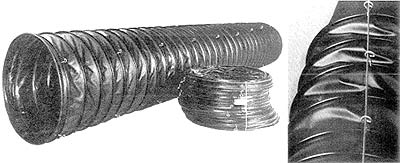11.2.3 Residual dust content
The maximum admissible residual dust content contained in the clean gas
is indicated in TA-Air; inorganic dusts are divided in three special categories
because of their toxicity.
Bag filters can have a residual dust content of 7 mg/m3 at most. The seams
of the individual bags are a weak point as regards bag filtering. When these
seams are agglutinated with polyester felt a value of 2 mg/m3 can be realised.
The residual dust content of a cartridge filter that can be achieved amounts
to some 2 mg/m3.
11.2.4 Comparison of the filter plants
Compared the other filter systems the compact construction is an advantage
of the cartridge filter plant. The filter space of a filter cartridge is,
for example, bigger by a factor of 7.5 compared to a filter hose of the same
diameter. This spatial advantage is reduced by the lower filter area loading
resulting form the star shape.
The filter area loading results from the ratio of crude gas volume flow
to filter area. For example: At a volume flow of 5,000 m3/h and a filter
are of 46 m2 (bag filter) or 70 m2 (cartridge filter) the following filter
area loadings result in a comparably big filter chamber:
fsB = 108.7 m3/h m2 (bag filter)
fsC = 71.4 m3/h m2 (cartridge filter)
Compared to bag filters the continuous dedusting of the cartridge filters
is a great advantage. The filter conditions can be maintained relatively
constantly by regular dedusting during operation. When dedusting the filter
bags, operation must, however, be interrupted during the cleaning process.
Furthermore, the filter conditions will change by the formation of a respective
filter cake in case of longer filtering without dedusting.
The pneumatic dedusting of the cartridges is more material-gentle than mechanical
dedusting of the filter bags. Reinforcements can be attached in the area
of the cogs to protect the filter bags against damages during dedusting.
11.2.5 Filter monitoring
The filter element clogs with increasing use resulting in an increase of
the pressure difference at the filter. If the resistance exceeds a limit
value and if sufficient cleaning is not possible any longer, then the filter
element will have to be replaced. This value is controlled by measuring the
pressure difference between filter chamber entry and exit.
11.2.6 Pressure losses
For sucking off dust-laden air both smooth pipes as well as air ducts can
be used to set up connection with the filter plant.
Air ducts are plastic hoses that are reinforced by a spiral made of spring
steel. According to the respective spiral distance the air duct can be used
for very different vacuums.
As a standard, air ducts are available at diameters ranging from 250 – 2400
mm and in single lengths of 5 and 10 m.
The pressure loss amounts to about 50 Pa per m/air duct (NW 300), as regards
a smooth pipe this value is only about 10 Pa per m/pipe (air velocity about
20 m/s).
The total pressure loss in a pipe transporting air should not exceed the
value of ventilator compression, if possible. If the pressure loss of the
plant is higher than the ventilator compression the air volume flow decreases.

Ill.: Air duct for mobile sucking off of dust-laden
air with filter plants
|



